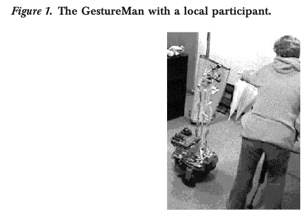Luff, P., Heath, C., Kuzuoka, H., Hindmarsh, J., Yamazaki, K., and Oyama, S. Fractured ecologies: Creating environments for collaboration. Human-Computer Interaction 18, 1&2 (2003), 51–84. [pdf]
———-
The authors conducted ethographical observations of participant pairs using GestureMan in a furniture organization task. The authors suggest that previous work seems to neglect the importance of the environment as a resource for collaboration. They highlight the importance of the body and oabjects withing the environment as resouces used to make sense of actions and intentions. In media spaces conducs is fractures from the environment in which it is produced, and from the environment in which it is received.
Participants using GestureMan reported difficulties in understanding where the remote collaborator was looking. The unnatural relation of the body of the local participant and the robot obscured some gestures to the remote participant. The laser pointer was a very valuable resources but it was also misleading as suggesting relations or orientation even when these were not relevant to the task or meant by the remote participant.
These technologies fracture the relation between conduct and the environment in which it is produced and understood. Ironically, the more we attempt to enhance the environment the more we might exacerbate the difficulties fro the participants themselves in the production and coordination o action.

